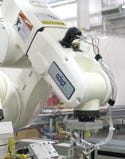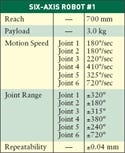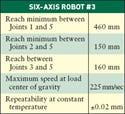Assessing Robot Performance for Device Manufacture
A properly selected and integrated robot can be a valuable asset for medical device manufacturers.
September 1, 2007
Automation
|
|
Six-axis articulated robots perform chassis-to-base needle insertion and placement on an insulin delivery pump. |
A medical device manufacturer with a robot that offers high- quality performance in terms of speed, precision, and durability possesses a valuable tool. Conversely, if a robot's use is based on misguided assumptions about its performance, or if it has not been properly integrated, it can be the biggest problem on the production floor.
When considering robotic automation of a task, it is imperative that medical product design and production engineers understand the fundamentals of robot operation. This article discusses these characteristics as well as a strategy for properly evaluating vendors and integrators of robots.
In medical device assembly, robots have often supplanted humans in repetitious, fatiguing tasks that require constant precision, flexibility, dexterity, and speed. There are a variety of applications in device manufacturing for which robots can be used. They include the following:
Small-parts assembly (dexterity, speed, and precision).
Part transfer (speed and software-driven decision making).
Part presentation (precision and speed).
Dispensing (speed and precision path).
Packaging (speed and flexibility).
Multiple part types (flexibility and programmability).
Testing
Although robots can be significant assets for medical OEMs, they can have serious limitations if improperly integrated. These limitations are not apparent in a robot's specification sheet, and vendors are often unlikely to inform OEMs about them.
|
Table I. (click to enlarge) Repeatability specifics and overall characteristics for a four-axis SCARA robot. |
Many device manufacturers do not have robotics expertise, and it may be to an OEM's benefit to form a partnership with a qualified, experienced robotics integrator. Unlike a robotics supplier, an integrator assumes the risk of a robot's performance in an application. Therefore, integrators must be impartial to a specific company's products and select the optimal robot for an application based on characteristics such as precision, settling time, and speed.
|
Table II. (click to enlarge) Repeatability specifics and overall characteristics for six-axis robot #1. |
Table I lists four typical specifications for a four-axis selectively compliant assembly robot arm (SCARA). Tables II, III, and IV list specifications for other six-axis articulated arms and demonstrate how each robot vendor presents repeatability differently. The SCARA specification notes each axis individually, but Robot #1 just lists a number, Robot #2 mentions an ISO test, and Robot #3 lists constant-temperature data. Each vendor supposedly collects a considerable amount of performance data guided by a standard, but no real details are presented. The lack of a standardized presentation for robot performance data makes it virtually impossible to make a robot selection using specifications only.
Proper robotics selection may require performing an independent comparison testing of the robot candidates. Speed, precision, and settling-time tests must be performed with a thorough understanding of a given robot's characteristics and the application for which it will be used.
|
Table III. (click to enlarge) Repeatability specifics and overall characteristics for six-axis robot #2. |
Two industry standards—ISO 9283 and ANSI/RIA R15.05—outline requirements for the performance testing of robots and data reporting methods. The two standards are sig- nificantly different in terms of test paths, terminology, and performance test specifications. In addition, some very important performance aspects—multidirectional performance testing, for example—are often vague, optional, or not considered in either standard.
|
Table IV. (click to enlarge) Repeatability specifics and overall characteristics for six-axis robot #3. |
Published specification data might also lack information to help OEMs determine which robot manufacturers test to a standard, and if they do, which standard they use and how closely they follow it. In addition, most suppliers do not reveal their internal testing results. This raises the following four key questions:
Under what conditions are published data valid?
What do the data mean?
Is robot performance guaranteed to meet the published specifications?
What important characteristic data are omitted and left to chance?
Understanding the Fundamentals
Resolution, repeatability, backlash, and accuracy are the fundamental characteristics of robot precision. The following definitions are provided to help understand the significance of these characteristics.
Resolution: signifies the smallest directional amount an axis can move.
Positional repeatability: the maximum radius of a sphere containing all of the end points achieved when moving to the same location from the same direction numerous times.
Backlash: the magnitude of the motion lost between driving and driven elements due to clearance between parts.
Positional accuracy: the maximum radius of a sphere containing all of the end points achieved when moving to the same location from multiple directions, in different poses, and numerous times. (When testing to the ANSI/RIA standard, this is performed at many points in the work space looking for the maximum error.)
|
Figure 1. (click to enlarge) Two-dimensional position repeatability and accuracy of a tool tip relative to a target point (0,0). |
Resolution, repeatability, and backlash are solely based on mechanical systems, but accuracy builds upon the mechanics with mathematical relationships added to relate each axis to the robot's kinematic model. Repeatability and accuracy are represented in Figure 1.
|
Figure 2. (click to enlarge) Relationships of serially linked axes. Mathematical relationships relate frame (n+1) to previous frame (n). |
Kinematics represents the static relationships needed to mathematically relate the robot's tool (flange) coordinate system to the real-world coordinate system. These relationships are in the form of lengths, offsets, and angular associations between serially linked axes (see Figure 2).
Mechanical inconsistencies and errors in these mathematical relationships are the major source of robot inaccuracies. The magnitude of inaccuracy increases when there are more degrees of freedom, the distance between axes grows, or rotary joints are featured rather than linear or fixed perpendicular joints (as found in SCARA robots). Errors compound nonlinearly as each axis is added to the serial stack.
Due to manufacturing differences, no two robots can ever be characterized as the same. Major dissimilarities include casting differences such as length and twist, bearing fits within the castings, and gear-train nonlinearities. The physical relationship between the robot's flange and its base must be defined, also called zeroing or mastering. Assuming good mechanical integrity and correctly defined link lengths and angular differences, 95% of a robot's volumetric positioning error can be eliminated.
To obtain the best model, each robot must undergo an elaborate procedure of commanding the arm to move through many poses, collecting measurement data, parameter fitting, and model correction. The care taken by a robot supplier in obtaining these is what sets one robot apart from another. Some robot suppliers spend little or no time obtaining these data. Rather, they have one set of parameters for all arms of a particular model. Some suppliers also assume that fixed perpendicular joints are perfectly orthogonal when that is not always the case. A robot company's design and testing philosophies dictate the integrity of the product. The details are in how a robot is manufactured, mastered, and verified.
Understanding Performance
It is important to note that a robot may not perform to its specified metrics because of the way the robot is implemented. Specific to the robotics automation requirements for an OEM's application, the following aspects must be considered:
Tool or no-tool offset and the length of the offset from the theta axis.
Performance at a specific location in a work cell or overall work cell.
Performance in different poses.
Payload, loaded, or unloaded (dynamic or gravity-induced change).
Cantilever of the arm at the working positions.
Duty cycle and ambient temperature fluctuations.
|
Figure 3. (click to enlarge) The effects of backlash, repeatability, and accuracy as they relate to travel. |
Axis gear trains are fundamental to robot motion. By far, gear-train backlash is the greatest impediment to the realization of presumed specification performance. It can be a result of insufficient axial preloads or poor meshing between drive-train components. Backlash, although always present, is almost impossible to quantify because of its dynamic characteristics. Figure 3 presents the effects of backlash, accuracy, and repeatability as they relate to travel.
In many applications, a robot's end tool is jogged to a work location using a teach pendant. By pressing a button, the location is stored, or taught, using recorded positions of each of the servo motors that make up the arm. In simple applications, work is performed by moving the robot through a series of taught locations while actuating some type of end-effector device. These types of applications rely solely on repeatability because the robot always approaches a location from the same direction. Because repeatability is unidirectional, and backlash is always present, it is possible that the point the robot was taught is not the point to which it will actually move. Even if the user is are aware of the presence of backlash, it is still difficult to teach a point while approaching in a specific direction.
Robotics companies often focus on repeatability and underrate a robot's need for other performance attributes. This is far from practical. Even for the simplest application, multidirectional position repeatability—a characteristic that factors into backlash—would be a more trustworthy characteristic to specify. Precision is one of the pillars of robot performance, and presumably robot manufacturers want to present the best data.
A robot is a mechanically intense system—not a trusted precision device. It is important for medical OEMs to realize that an improperly integrated robot can have serious limitations, so each application must be critically assessed. Multidirectional repeatability and accuracy are the performance characteristics that are most often overlooked. As a rule of thumb, these characteristics are most important when
It is critical to precisely teach and move to a point.
A robot approaches a location from more than one direction.
Its final location is altered based on an offset.
Its final location is related to the real-world coordinate space (i.e., computer-aided design data for a precisely dimensioned product).
Consider the following applications:
A move offset is calculated based on feedback from a vision system or a proximity or laser sensor.
The robot's tool coordinate system is related to real-world space applications, such as gauging and measuring; path following, such as in dispensing; or off-line programming.
Vision guidance, including conveyor tracking.
Deburring, welding, and brazing.
A multistation work cell where the robot approaches from different directions.
Robot-to-robot work sharing.
Replacement of a failed robot with minimal effect on location and path integrity.
These applications represent a significant portion of the duties performed by robots for medical device OEMs, and they all rely on either multidirectional repeatability or accuracy. Again, these characteristics are not included in the specifications presented by most robotics suppliers; therefore, an arm's performance in a these common applications is anything but certain.
Performance Realities: Test Data
|
Figure 4. (click to enlarge) A Doppler laser functions as an easily aligned interferometer. The retroreflector is attached directly to the robot flange. Pictured is a Doppler laser kit (left) and an output graph with data obtained using high-speed acquisition mode. |
Based on industry standards for performance testing of robots, testing procedures have been developed that more closely relate robot characteristics to the types of applications previously outlined. Testing has been conducted on many robots from different suppliers using a Doppler laser (see Figure 4). A Doppler laser obtains line-of-sight position data. Under controlled environmental conditions, measurement accuracy can be greater than 100 nm. The laser offers some unique features, including acquisition and plotting of position data at kilohertz frequencies.
Specialized test criteria were developed based on the ANSI standard, common medical device manufacturing requirements, and the single-line nature of the Doppler laser. The characteristics tested for include the following:
Bidirectional repeatability.
Absolute accuracy.
Accuracy and repeatability differences in different poses, with different payloads (half and full), with and without a 75-mm offset tool attached, and cold and warm.
Minimum achievable theta increment.
Settling time moving short distances with position stabilizing to an arm's specified repeatability.
Point-to-point cycle times.
|
Figure 5. (click to enlarge) Isometric and plane views of the location of the standard test plane within a typical robot envelope. |
The standard test line is within the standard plane defined by ANSI/RIA R15.05. The line reaches to the extent of the robot's reach and is set at a 45° angle to the world coordinate system (see Figure 5). The laser retroreflector is attached and offset 75 mm from the flange's center. A tool transformation is applied, and the robot traverses the path point to point while going through extreme pose differences.
SCARA robots are tested in right- and left-handed configurations to the left and right of the Y-axis. Six-axis robots are tested in a similar area, but the pose differences are flange horizontal and flange vertical in an upper configuration. All robots are tested on the same sand-filled, cast-iron base in the same environment.
|
Figure 6. (click to enlarge) A comparison of a SCARA robot with and without a tool offset. |
Five sets of actual test data are presented (see Figures 6–10). These comparisons highlight unexpected specification performance differences that any OEM integrating or specifying a robot should be aware of.
Figure 6 presents a SCARA arm with and without a 75-mm tool offset. When a tool offset is applied to a robot about the Z-axis (theta), the minor axes move through a greater range of motion than without an offset. Because of the offset, a small angular error quickly develops into significant X-Y errors at the tool. The amount of backlash and stiction in the drive train between an axis output and its encoder dictates the minimum move increment and the inertia that the robot can reliably position. When using a tool offset, an important property is the minimum repeatable bidirectional move achievable on each minor axis (in this case, theta).
|
Figure 7. (click to enlarge) A comparison of a SCARA robot in right- and left-handed positions. |
Data from a SCARA arm in right- and left-handed configurations are presented in Figure 7, which reveals some indications of kinematic integrity. A simple test is to teach a point and move to that point in different arm configurations. Measurable differences in position in different poses reveal potential kinematic problems. Often large differences can be improved by rezero- ing the robot.
|
Figure 8. (click to enlarge) A comparison of the same six-axis robot in Figure 10, along the same path, in flange horizontal and flange vertical poses. Note the rapid change in accuracy (0.3 mm/100 mm) in the latter part of the first graph. |
Figure 8 shows results from a six-axis arm in flange horizontal and flange vertical pose configurations. A six-axis robot is typically used to make moves that require the flange to be in any orientation except horizontal. With a turn of the wrist, this robot's characteristics change drastically. The vertical graph clearly shows the significance of backlash. With a requirement of multidirectional repeatability, the flange vertical bidirectional repeatability numbers for this robot would raise questions about its usefulness in any application. They also emphasize the need for proper robot selection.
|
Figure 9. (click to enlarge) A comparison of two different six-axis robots along a similar path in flange vertical. |
Two different six-axis arms in a flange vertical pose configuration are shown in Figure 9. Brand B robot has better performance characteristics even though its reach is almost twice that of Brand A.
Note the erratic nature of some of the point curves in these figures. Be cognizant of approach directionality and how quickly the slopes or the direction of the slopes can change. Imagine how subtle implementation changes like reteaching a point or even executing a speed change can affect precision. Using a robot in critical medical device applications without considering these idiosyncrasies could be disastrous.
|
Figure 10. (click to enlarge) Within the time duration shown, this SCARA robot never settles to its in-position tolerance. The repeatability specification for this arm is 0.02 mm. |
In-position settling time is critical in applications that need fast, precise placement. The settling time for a SCARA robot is presented in Figure 10. However, some arms just do not settle well. After 350 ms, this robot has not settled to its specified repeatability. In fact, this arm took almost 2 seconds to do so. Remember, the specification mentions repeatability, but it does not mention how long after the completion of the move it takes to settle to a final location. The settling-time data presented here are atypical, but again emphasize the importance of robot selection.
Many techniques can be used to circumvent known performance deficiencies. For instance, an assembly method that relies on unidirectional repeatability rather than multidirectional repeatability or accuracy may be feasible. Techniques that can rely solely on resolution rather than repeatability are another possibility. To avoid costly reengineering, these techniques should be considered during initial design. Integration experience and innovation are vital to realizing if these methods are suitable for an OEM's application.
Conclusion
The realities of robot performance are largely untold. Published specifications often fail to provide the level of information needed for an OEM to make an appropriate robot selection. Depending on the criticality of the application, independent testing is sometimes necessary. Robot performance cannot be assumed. To properly integrate and maintain a robot in a medical device application, performance metrics and how they relate to the job at hand must be well understood.
Bruce Fiala is senior software engineer in the Robotics and Vision Group at Wright Industries (Nashville, TN), a Doerfer company. He can be contacted at [email protected].
Copyright ©2007 Medical Device & Diagnostic Industry
About the Author(s)
You May Also Like
















.png?width=300&auto=webp&quality=80&disable=upscale)

